September is one of my favorite months, for the hummingbirds are moving through Texas in large numbers at this time, and it means my garden is busy with little bird antics left and right (and up and down).
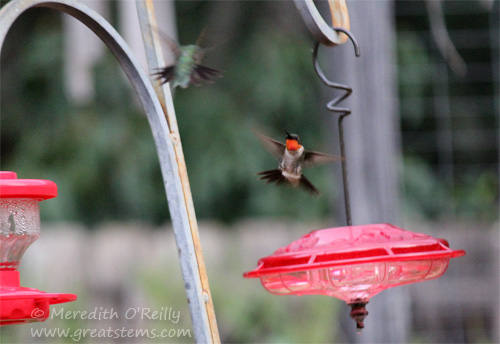 The sounds of the feisty little birds draw me outside. The hummingbirds are usually so focused on defense and territoriality and getting nectar that they hardly noticed the humans taking pictures, dogs running amok, and thunder or other noises in the background. Such was this evening’s setting.
The sounds of the feisty little birds draw me outside. The hummingbirds are usually so focused on defense and territoriality and getting nectar that they hardly noticed the humans taking pictures, dogs running amok, and thunder or other noises in the background. Such was this evening’s setting.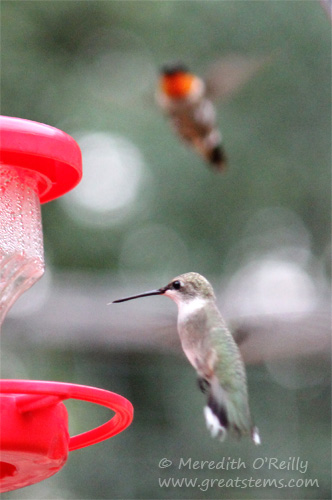
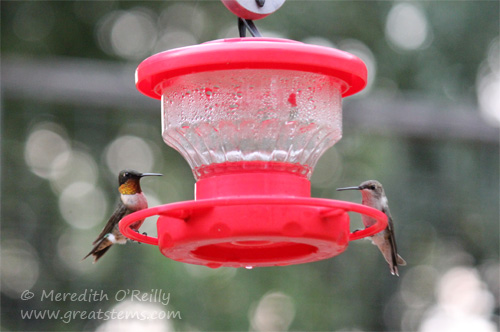 Occasionally hummingbirds will settle down and share a feeder. In fact, as more hummers appear during migration, they will share more and more, as the need to build up energy stores for long-distance travel becomes more pressing.
Occasionally hummingbirds will settle down and share a feeder. In fact, as more hummers appear during migration, they will share more and more, as the need to build up energy stores for long-distance travel becomes more pressing.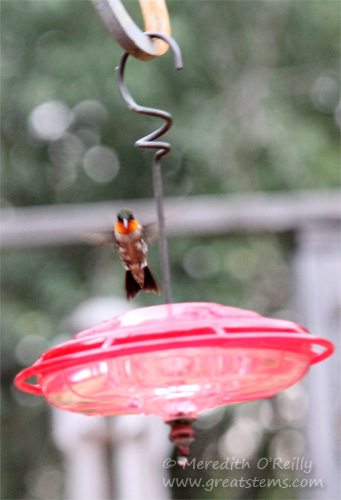 During migration season, the vast majority of the hummingbirds I see in my Austin garden are Ruby-throats. The males have the iridescent gorget, which seems truly vibrant when the light is just right (but otherwise it looks dark).
During migration season, the vast majority of the hummingbirds I see in my Austin garden are Ruby-throats. The males have the iridescent gorget, which seems truly vibrant when the light is just right (but otherwise it looks dark).
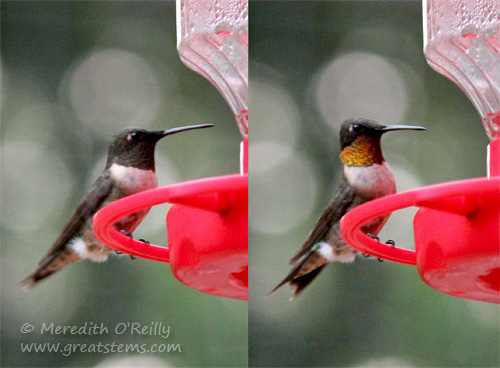
Because the male’s gorget often appears dark, Ruby-throats are often confused with Black-chinned hummers. But take a look at how this male’s feathers light up with just a slight change to its body position. The color you see is actually a function of feather structure and the refraction of light at particular angles and is not a result of pigmentation.
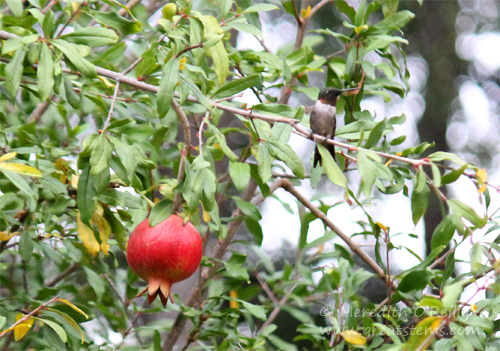
Don’t be fooled into thinking this hummingbird, almost hidden among the leaves, is remarkably big, given the pomegranate nearby as a size comparison. That’s actually a small pomegranate (the big pomegranates have weighed their respective branches down much closer to the ground, and no hummingbirds ever hang out down there).
Aside from the feeders, our backyard trees are territorial zones for many of the hummingbirds, who stake claim not just to particular trees but to very specific branches on said trees. The bird above was the only one using that spot on the Pomegranate — he drove away any other hummer that came too close. Likewise, the Mexican Redbuds were claimed by a few hummingbirds, likely because they were close to three feeders. The nearby Oak trees offered higher vantage points, so some hummingbirds used those instead.
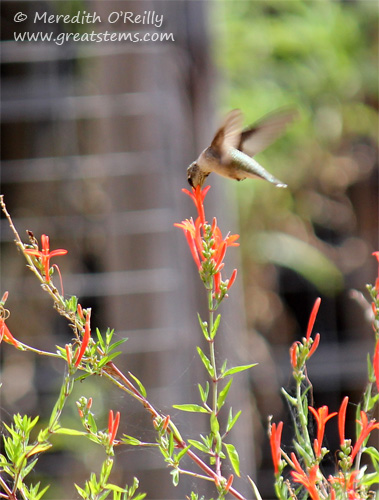
Of course, native plants offer the best nectar of all, but I always put out feeders during migration because it can be hit or miss whether any of my natives are blooming in the hot Texas summer. Often, I’m relying on my trusty Flame Acanthus to be in bloom while summer is still blazing. Indeed, my Flame Acanthus is blooming right now, but I’m cheating and showing a picture I took last year. And actually, fyi, I keep feeders up year round, though perhaps not as many in the winter. You never know when a slowpoke hummingbird will desperately be seeking food sources in the cold.
If you have feeders, be sure to use a ratio of 1 part Table Sugar to 4 parts water — don’t add coloring.
And always keep your feeders clean! Replace the sugar-water every 2-3 days to prevent fermentation, and use that opportunity to scrub out the feeders thoroughly. I use vinegar to clean mine (and small brushes). Don’t let any black yucky stuff build up in those nooks and crannies!
For those of you up north who are saying a seasonal goodbye to hummingbirds, thank you for taking good care of them. They’ll be back in the spring to say hello before you know it!
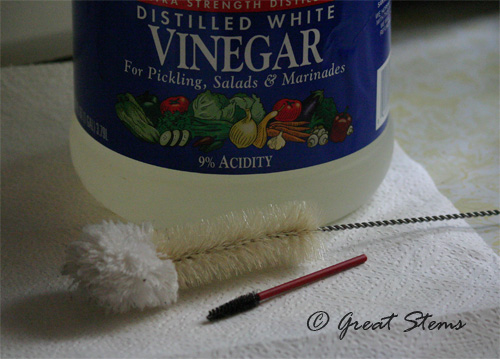
This is a bittersweet time for me, as the hummer activity increases so much — I counted a dozen hummers at once zooming around a few years ago — but it also means there’s not much time left before they’re all gone. 🙁
Oh, I know. Even though we see them a little later than all you northern folks do, we still have to say goodbye in due time. Migration must happen!
So that’s where all my little friends have gone! They are already in Texas, enjoying your garden. Fill them up good before you send them on their way.
Ours moved on with the cold front — we’re ready for the next batch of hummingbirds!